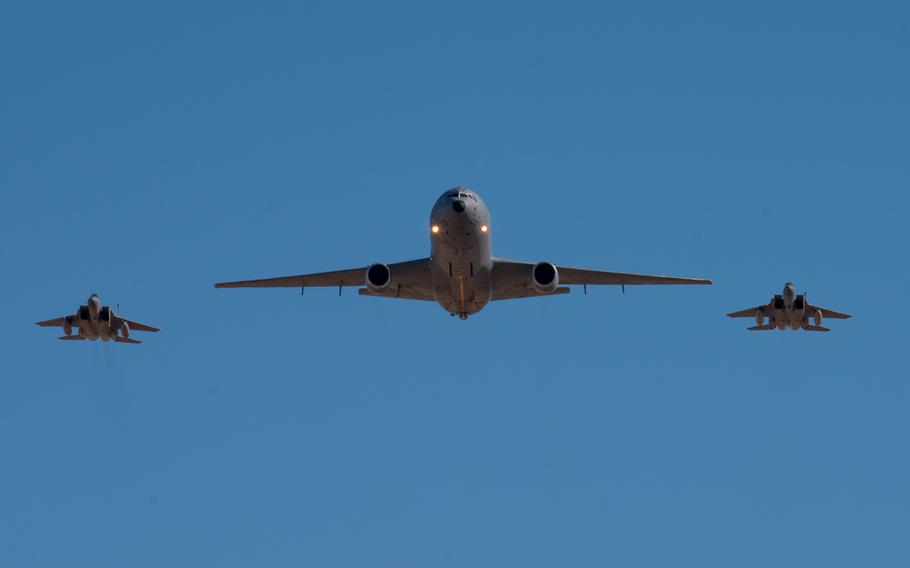
The last U.S. Air Force KC-10 Extender and two F-15Es Strike Eagle assigned to Fresno Air National Guard Base, Calif., fly in formation during the KC-10 farewell ceremony at Travis Air Force Base, Calif., Sept. 26, 2024. (Kenneth Abbate/U.S. Air Forced)
The last U.S. Air Force KC-10 Extender was decommissioned after 44 years of service during a final farewell ceremony Thursday at Travis Air Force Base in California.
Service members, veterans, military and local community leaders gathered to bid farewell to the aircraft and commemorated its rich history since it entered service in 1981.
“What I want to do is say thank you to all of you, to every one of you, for everything you have given that [KC-10] machine,” said Gen. Paul Selva, former vice chairman of the Joint Chiefs of Staff and former 9th Air Refueling Squadron commander. “Whether you are a maintainer, an operator, or a member of the support team that makes it possible for us to fly the airplane, you have made the reputation that is the KC-10. ... This is not the end of an era, it’s just another chapter of a long story.”
The KC-10 was designed to provide increased global mobility for U.S. armed forces. Although its primary mission was aerial refueling, it also provided airlift of personnel and equipment on overseas deployments.
Beyond combat operations, the KC-10 and its crews provided essential support in humanitarian missions. Its refueling capabilities and cargo capacity enabled rapid response to natural disasters, such as hurricane relief and earthquake recovery efforts, in ensuring timely aid delivery to those in need.
The KC-10 — sometimes called “Big Sexy” — was used during the 1991 Gulf War, and flew more than 1,300 missions in the wars in Iraq and Afghanistan, according to the fact sheet.
Since 9/11, the KC-10 has flown more than 350 missions guarding U.S. skies as a part of Operation Noble Eagle.
The final destination for the aircraft will be with the 309th Aerospace Maintenance and Regeneration Group at Davis-Monthan Air Force Base, Ariz., which provides aircraft preservation and storage, parts reclamation, disposal preparation, aircraft regeneration to flying status and depot maintenance for America’s military services, U.S. government agencies and allied governments.
As the KC-10 retires, the Air Force is replacing it with the KC-46A Pegasus. As of September, 88 KC-46s have been delivered.
“The KC-10’s legacy is not just about the collection of impressive statistics, but more importantly, it’s about the people, community and the airmen who made the aircraft what it is,” said Col. Jay Johnson, 60th Air Mobility Wing commander. “As the KC-10 takes its last flight, its legacy doesn’t end. With that last touchdown, those lessons will be passed on through friendship, through the knowledge you all have passed down through generations.”

The last U.S. Air Force KC-10 Extender takes off from the flight line during the KC-10 farewell ceremony at Travis Air Force Base, Calif., Sept. 26, 2024. As the final base to operate the KC-10, Travis AFB had the honor of bidding farewell to the aircraft after its 44 years of service. (Kenneth Abbate/U.S. Air Force)